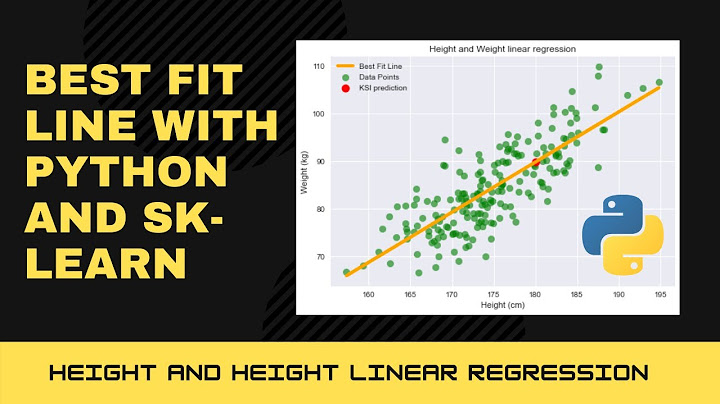How to get slope from timeseries data in pandas?
Solution 1
I will take part of Franco answer, but you don't need sklearn. You can easily do it with scipy.
import datetime as dt
from scipy import stats
df = pd.DataFrame(list, columns=['date', 'value'])
df.date =pd.to_datetime(df.date)
df['date_ordinal'] = pd.to_datetime(df['date']).map(dt.datetime.toordinal)
slope, intercept, r_value, p_value, std_err = stats.linregress(df['date_ordinal'], df['value'])
slope
Out[114]: 0.80959404761905
Solution 2
You can use datetime.toordinal to map each date to an integer and sklearn.linear_model to fit a linear regression model on your data to obtain the slope like:
import datetime as dt
from sklearn import linear_model
df = pd.DataFrame(list, columns=['date', 'value'])
df['date_ordinal'] = pd.to_datetime(df['date']).map(dt.datetime.toordinal)
reg = linear_model.LinearRegression()
reg.fit(df['date_ordinal'].values.reshape(-1, 1), df['value'].values)
reg.coef_
array([0.80959405])
Solution 3
To get the slope and intercept of a linear regression line (y = intercept + slope * x) for a simple case like this, you need to use numpy polyfit() method. My explanation is inline with code below.
# You should only need numpy and pandas
import numpy as np
import pandas as pd
# Now your list
list = [('2018-10-29', 6.1925), ('2018-10-29', 6.195), ('2018-10-29', 1.95833333333333),
('2018-10-29', 1.785), ('2018-10-29', 3.05), ('2018-10-29', 1.30666666666667),
('2018-10-29', 1.6325), ('2018-10-30', 1.765), ('2018-10-30', 1.265),
('2018-10-30', 2.1125), ('2018-10-30', 2.16714285714286), ('2018-10-30', 1.485),
('2018-10-30', 1.72), ('2018-10-30', 2.754), ('2018-10-30', 1.79666666666667),
('2018-10-30', 1.27833333333333), ('2018-10-30', 3.48), ('2018-10-30', 6.19),
('2018-10-30', 6.235), ('2018-10-30', 6.11857142857143), ('2018-10-30', 6.088),
('2018-10-30', 4.3), ('2018-10-30', 7.80666666666667),
('2018-10-30', 7.78333333333333), ('2018-10-30', 10.9766666666667),
('2018-10-30', 2.19), ('2018-10-30', 1.88)]
# Create a single pandas DataFrame
df = pd.DataFrame(list)
# Make it into a Time Series with 'date' and 'value' columns
ts = pd.DataFrame(list, columns=['date', 'value'])
#print it to check it
ts.head(10)
# Now separate it into x and y lists
x = ts['date']
y = ts['value'].astype(float)
# Create a sequance of integers from 0 to x.size to use in np.polyfit() call
x_seq = np.arange(x.size) # should give you [ 0 1 2 3 4 ... 26]
# call numpy polyfit() method with x_seq, y
fit = np.polyfit(x_seq, y, 1)
fit_fn = np.poly1d(fit)
print('Slope = ', fit[0], ", ","Intercept = ", fit[1])
print(fit_fn)
Slope = 0.1366855921855925 , Intercept = 1.9827865961199274
0.1367 x + 1.983
Related videos on Youtube
Souvik Ray
Updated on September 15, 2022Comments
-
Souvik Ray over 1 year
I have a pandas dataframe which contains
dateand some values something like belowOriginal data:
list = [('2018-10-29', 6.1925), ('2018-10-29', 6.195), ('2018-10-29', 1.95833333333333), ('2018-10-29', 1.785), ('2018-10-29', 3.05), ('2018-10-29', 1.30666666666667), ('2018-10-29', 1.6325), ('2018-10-30', 1.765), ('2018-10-30', 1.265), ('2018-10-30', 2.1125), ('2018-10-30', 2.16714285714286), ('2018-10-30', 1.485), ('2018-10-30', 1.72), ('2018-10-30', 2.754), ('2018-10-30', 1.79666666666667), ('2018-10-30', 1.27833333333333), ('2018-10-30', 3.48), ('2018-10-30', 6.19), ('2018-10-30', 6.235), ('2018-10-30', 6.11857142857143), ('2018-10-30', 6.088), ('2018-10-30', 4.3), ('2018-10-30', 7.80666666666667), ('2018-10-30', 7.78333333333333), ('2018-10-30', 10.9766666666667), ('2018-10-30', 2.19), ('2018-10-30', 1.88)]After loading into pandas
df = pd.DataFrame(list) 0 1 0 2018-10-29 6.192500 1 2018-10-29 6.195000 2 2018-10-29 1.958333 3 2018-10-29 1.785000 4 2018-10-29 3.050000 5 2018-10-29 1.306667 6 2018-10-29 1.632500 7 2018-10-30 1.765000 8 2018-10-30 1.265000 9 2018-10-30 2.112500 10 2018-10-30 2.167143 11 2018-10-30 1.485000 12 2018-10-30 1.720000 13 2018-10-30 2.754000 14 2018-10-30 1.796667 15 2018-10-30 1.278333 16 2018-10-30 3.480000 17 2018-10-30 6.190000 18 2018-10-30 6.235000 19 2018-10-30 6.118571 20 2018-10-30 6.088000 21 2018-10-30 4.300000 22 2018-10-30 7.806667 23 2018-10-30 7.783333 24 2018-10-30 10.976667 25 2018-10-30 2.190000 26 2018-10-30 1.880000This is how I load up the dataframe
df = pd.DataFrame(list) df[0] = pd.to_datetime(df[0], errors='coerce') df.set_index(0, inplace=True)Now I want to find the
slope. Upon research in the internet, I found this is what is needed to be done to get theslopetrend_coord = list(map(list, zip(df.index.strftime('%Y-%m-%d'), sm.tsa.seasonal_decompose(df.iloc[:,0].values).trend.interpolate(method='linear',axis=0).fillna(0).values))) results = sm.OLS(np.asarray(sm.tsa.seasonal_decompose(df.iloc[:,0].values).trend.interpolate(method='linear', axis=0).fillna(0).values), sm.add_constant(np.array([i for i in range(len(trend_coord))])), missing='drop').fit() slope = results.params[1] print(slope)But I get the below error
Traceback (most recent call last): File "/home/souvik/Music/UI_Server2/test35.py", line 11, in <module> trend_coord = list(map(list, zip(df.index.strftime('%Y-%m-%d'), sm.tsa.seasonal_decompose(df.iloc[:,0].values).trend.interpolate(method='linear',axis=0).fillna(0).values))) File "/home/souvik/django_test/webdev/lib/python3.5/site-packages/statsmodels/tsa/seasonal.py", line 127, in seasonal_decompose raise ValueError("You must specify a freq or x must be a " ValueError: You must specify a freq or x must be a pandas object with a timeseries index with a freq not set to NoneNow if I add a
freqparameter to the seasonal_decompose method such astrend_coord = list(map(list, zip(df.index.strftime('%Y-%m-%d'), sm.tsa.seasonal_decompose(df.iloc[:,0].values, freq=1).trend.interpolate(method='linear',axis=0).fillna(0).values)))Then I get an error like
Traceback (most recent call last): File "/home/souvik/Music/UI_Server2/test35.py", line 11, in <module> trend_coord = list(map(list, zip(df.index.strftime('%Y-%m-%d'), sm.tsa.seasonal_decompose(df.iloc[:,0].values, freq=1).trend.interpolate(method='linear',axis=0).fillna(0).values))) AttributeError: 'numpy.ndarray' object has no attribute 'interpolate'However if I get rid of any fine graining of data such as
interpolateetc and do something like belowtrend_coord = sm.tsa.seasonal_decompose(df.iloc[:,0].values, freq=1, model='additive').trend results = sm.OLS(np.asarray(trend_coord), sm.add_constant(np.array([i for i in range(len(trend_coord))])), missing='drop').fit() slope = results.params[1] print(">>>>>>>>>>>>>>>> slope", slope)Then I get a
slopevalue of0.13668559218559242.But I am not sure if this is the correct way to find out the
slopeand if even the value is right.Is there a better way to find out
slope?-
 Patrick Artner over 5 yearsdont call variables after built ins - you are shadowing them. It is a bad habit to use
Patrick Artner over 5 yearsdont call variables after built ins - you are shadowing them. It is a bad habit to uselist,dict,tuple,set,max,min,abs,sum,...as variable names.
-
-
 David García Bodego over 4 yearsWelcome to SO! When you give an answer, eve if it is right, try to explain it a little bit.
David García Bodego over 4 yearsWelcome to SO! When you give an answer, eve if it is right, try to explain it a little bit. -
seedhom about 4 yearsBTW, the above answer is for python 3 only









